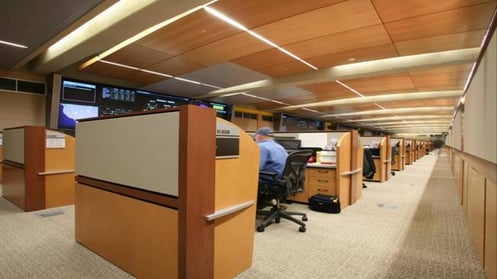- Blog
- Control Rooms (26)
- Events (21)
- Public Safety (21)
- Team (19)
- Ergonomics (9)
- Product (8)
- Mission-Critical (7)
- Console Cleaning (5)
- Air Traffic Control Towers (4)
- Acoustics (3)
- Denise Amber Lee Foundation (2)
- Government (2)
- NASA (2)
- GSOC (1)
- Oil & Gas Control Rooms (1)
- Project of the Month (1)
- Virtual Reality (1)
- Warranty (1)
It’s easy to overlook how much acoustics impact control room solutions, and more importantly the operators within it. Not only is it distracting and the potential cause of miscommunication, but ambient noise over a long period can lead to decreased operator health, headaches, and noise complaints. Here are three ways to mitigate these harmful, but often necessary control room sounds…
What Should You Ask Your Control Room Operators About Acoustics?
Learning how sound behaves with your operations center will help determine if you need room acoustic controls put in place. Is your room larger than most? Do you have high ceilings? Do you rely on video/audio communication, and often have human chatter? Do your operators often have to talk loudly over equipment to communicate with others? Do operators monitor audible alarms or radio channels? These are all important questions to ask yourself to determine the control room acoustic treatments you may need.
controls put in place. Is your room larger than most? Do you have high ceilings? Do you rely on video/audio communication, and often have human chatter? Do your operators often have to talk loudly over equipment to communicate with others? Do operators monitor audible alarms or radio channels? These are all important questions to ask yourself to determine the control room acoustic treatments you may need.
How Do You Leverage Acoustics for Productive Control Room Operators?
Proper acoustic interior design can mitigate any sound distractions, ensuring your operators are more productive and healthier. Different items, materials, and textures can all affect how sound works and bounces throughout a space. Any flat, uniform surface can reflect sound, so ensuring the walls, ceiling, and floors are constructed from or covered in diffusing materials like carpet, foam or acoustic panels can prevent reflected and bounced audio.
How Do You Control Unwanted Sounds In Your Control Room?
While control rooms have many necessary sounds, from alarms to operators discussing current conditions, the ability to control them is paramount to ensuring a healthy  environment. In the industry, items called “diffusers” spread out the frequencies of sound disrupting sound paths. They are placed strategically around the room to be effective. Sound showers can also be used to isolate and direct sounds to their sole recipient without adding to the overall noise of the environment.
environment. In the industry, items called “diffusers” spread out the frequencies of sound disrupting sound paths. They are placed strategically around the room to be effective. Sound showers can also be used to isolate and direct sounds to their sole recipient without adding to the overall noise of the environment.
For more on control room sound and acoustic interior design, read this post from Evans acoustic solutions expert, Kerri Knox.
Topics: Acoustics, Control Rooms
 The Power of Acoustics in the Control Room
The Power of Acoustics in the Control Room
